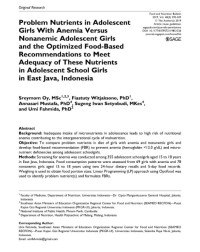Problem Nutrients in Adolescent Girls With Anemia Versus Nonanemic Adolescent Girls and the Optimized Food-Based Recommendations to Meet Adequacy of These Nutrients in Adolescent School Girls in East Java, Indonesia

Author
Sreymom Oy - Personal NameFiastuty Witjaksono - Personal Name
Annasari Mustafa - Personal Name
Sugeng Iwan Setyobudi - Personal Name
Umi Fahmida - Personal Name
Background: Inadequate intake of micronutrients in adolescence leads to high risk of nutritional anemia contributing to the intergenerational cycle of malnutrition.
Objective: To compare problem nutrients in diet of girls with anemia and nonanemic girls and develop food-based recommendation (FBR) to prevent anemia (hemoglobin kurang 12.0 g/dL) and micronutrient deficiencies among adolescent schoolgirls.
Methods: Screening for anemia was conducted among 355 adolescent schoolgirls aged 15 to 18 years in East Java, Indonesia. Food consumption patterns were assessed from 69 girls with anemia and 78 nonanemic girls aged 15 to 18 years using two 24-hour dietary recalls and 5-day food records. Weighing is used to obtain food portion sizes. Linear Programming (LP) approach using Optifood was used to identify problem nutrient(s) and formulate FBRs.
Results: Iron and calcium were problem nutrients among nonanemic girls, while iron, calcium, folate, and vitamin A were problem nutrients among anemic girls. Milk and liver were potential nutrient-dense foods identified to fill the nutrient gaps. Six FBRs would ensure the dietary adequacy for 9 of 12 nutrients except for iron, folate, and calcium.
Conclusions: Anemic girls had more problem nutrients compared to their nonanemic counterparts. The FBRs developed using LP can meet adequacy of most nutrients except iron, folate, and calcium. Nutrient gap identified from LP analysis suggests that it is advisable to add a mixture of weekly iron and folate supplement for adolescent girls in order to meet adequacy of iron and folate to prevent anemia.
Detail Information
| Series Title | : | - |
| Call Number | : | - |
| Publisher | : | : Food and Nutrition Bulletin., 2019 |
| Collation | : | Food and Nutrition Bulletin 2019, Vol. 40(3) 295-307 |
| Language | : | English |
| ISBN/ISSN | : | - |
| Classification | : | NONE |
 Computer Science, Information & General Works
Computer Science, Information & General Works  Philosophy & Psychology
Philosophy & Psychology  Religion
Religion  Social Sciences
Social Sciences  Language
Language  Pure Science
Pure Science  Applied Sciences
Applied Sciences  Art & Recreation
Art & Recreation  Literature
Literature  History & Geography
History & Geography